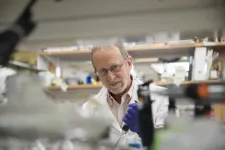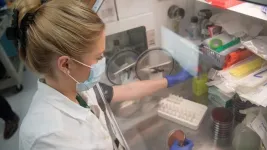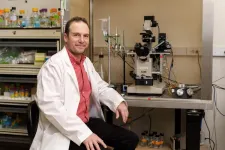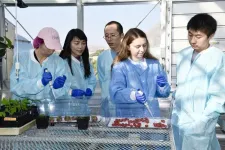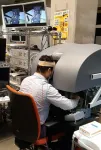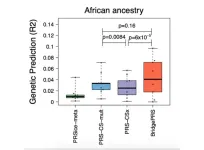(Press-News.org) University of Virginia Alzheimer’s researchers have discovered how harmful tau proteins damage the essential operating instructions for our brain cells, a finding which could lead to new treatments.
The toxic protein, the researchers found, warps the shape of the nuclei of nerve cells, or neurons. This alters the function of genes contained inside and reprograms the cells to make more tau.
While the protein has long been a prime suspect in Alzheimer’s and other neurodegenerative “tauopathies,” the new research from UVA’s George Bloom, Ph.D.; his recently graduated student Xuehan Sun, Ph.D.; and collaborators is among the first to identify concrete physical harms that tau causes to neurons. As such, it offers researchers exciting leads as they work to develop new treatments for Alzheimer’s disease and tauopathies, which are now untreatable.
“A lot of fantastic research has been done by other labs to learn how toxic tau spreads from neuron to neuron in the brain, but very little is known about exactly how this toxic tau damages neurons, and that question is the motivation for our new paper,” said Bloom, of UVA’s Departments of Biology, Cell Biology and Neuroscience, as well as the UVA Brain Institute, the Virginia Alzheimer’s Disease Center and UVA’s Program in Fundamental Neuroscience. “The toxic tau described here is actually released from neurons, so if we can figure out how to intercept it when it’s floating around in the brain outside of neurons, using antibodies or other drugs, it might be possible to slow or halt progression of Alzheimer’s disease and other tauopathies.”
Alzheimer's and Tauopathies
Tauopathies are characterized by the buildup of tau inside the brain. Alzheimer’s disease is well known, but there are many other tauopathies, including frontotemporal lobar degeneration, progressive supranuclear palsy and chronic traumatic encephalopathy. These diseases typically present as dementia, personality changes and/or movement problems. There are no treatments available for non-Alzheimer’s tauopathies, so the UVA researchers were eager to better understand what is happening, so that scientists can find ways to prevent or treat it.
Bloom and his team discovered that tau “oligomers” – assemblages of multiple tau proteins – can have dramatic effects on the normally smooth shape of neuronal nuclei. The oligomers cause the nuclei to fold in on themselves, or “invaginate,” disrupting the genetic material contained within. The physical location and arrangement of genes affects how they work, so this unnatural rearrangement can have dire effects.
“Our discovery that tau oligomers alter the shape of the nucleus drove us to the next step – testing the idea that changes in gene expression are caused by the nuclear shape change,” Bloom said. “That’s exactly what we saw for many genes, and the biggest change is that the gene for tau itself increases its expression almost three-fold. So bad tau might cause more bad tau to be made by neurons – that would be like a snowball rolling downhill.”
The researchers found that patients with Alzheimer’s disease had twice as many invaginated nuclei as people without the condition. Increases were also seen in lab mice used as models of Alzheimer’s and another tauopathy.
The researchers say that additional research into how this process happens could open the door to new ways to prevent and treat Alzheimer’s and other tauopathies.
Findings Published
The researchers have published their findings in the scientific journal Alzheimer’s & Dementia. The article is open access, meaning it is free to read. The research team consisted of Xuehan Sun, Guillermo Eastman, Yu Shi, Subhi Saibaba, Ana K. Oliveira, John R. Lukens, Andrés Norambuena, Joseph A. Thompson, Michael D. Purdy, Kelly Dryden, Evelyn Pardo, James W. Mandell and Bloom. The researchers have no financial interest in the work.
The research was supported by the National Institutes of Health, grant RF1 AG051085; the Owens Family Foundation; the Cure Alzheimer’s Fund; Rick Sharp Alzheimer’s Foundation; Webb and Tate Wilson; and the NanoString nCounter Grant Program.
To keep up with the latest medical research news from UVA, subscribe to the Making of Medicine blog.
END
Alzheimer’s discovery reveals dire effect of toxic tau protein on brain cells
2023-12-20
ELSE PRESS RELEASES FROM THIS DATE:
Fraunhofer USA releases Annual Research Report, Focus 2023
2023-12-20
Fraunhofer USA, a leading nonprofit research organization dedicated to applied research and development services, is proud to announce the release of its Annual Report, Focus 2023. The report underscores Fraunhofer USA's commitment to fostering transatlantic collaboration, strengthening university-government partnerships, and driving impactful technology transfer.
Transatlantic Collaboration: A Pillar of Innovation
In the pursuit of global innovation, Fraunhofer USA continues to play a pivotal role in fostering transatlantic collaboration. The annual report highlights the organization's successful partnerships with Fraunhofer-Gesellschaft research institutes, resulting in groundbreaking ...
International collaboration to improve cancer care in Sub-Saharan Africa updates resources for sixth year
2023-12-20
PLYMOUTH MEETING, PA [December 20, 2023] — The National Comprehensive Cancer Network® (NCCN®)—an alliance of leading academic cancer centers in the United States—is celebrating six years of working alongside the African Cancer Coalition (ACC), the American Cancer Society (ACS), and the Clinton Health Access Initiative (CHAI), as part of Allied Against Cancer. The collaboration was formed to support and empower the Sub-Saharan African oncology community to advance health system capacity, ...
New study sheds light on the connection between the microbiome and kidney stones
2023-12-20
A new study from Lawson Health Research Institute and Western University published in the journal Microbiome has found changes in the microbiome in multiple locations in the body are linked to the formation of kidney stones.
The human microbiome comprises trillions of microorganisms, including healthy bacteria. In recent years, research has begun to uncover its role in health and numerous diseases.
The research team examined the gut, urinary and salivary microbiomes in 83 patients who had kidney stones ...
TTUHSC researcher studies the ability of brine shrimp to thrive in high salinity
2023-12-20
Brine shrimp of the genus Artemia are small crustaceans that can thrive in environments where sodium concentrations are as high as 25% (more than eight times typical ocean sea water). Also known by the household pet trademark ‘sea monkeys,’ these animals are abundant in inland salt lakes where brine-fly larvae are the only other animals known to exist.
The mechanisms which permit brine shrimp to tolerate some of the harshest environments are only partially understood. Previously known adaptive features include a tight protective layer (integument) to avoid water loss and the increased extrusion of sodium (Na+) and chloride (Cl-) ions ...
Digital training program improves quality of life for care residents with dementia – even during the COVID-19 pandemic
2023-12-20
Quality of life for people with dementia living in residential and nursing home care substantially improved after staff took part in a digital training programme that was specially adapted to Covid-19 restrictions. The training also led to a significant drop in the prescription of potentially harmful sedative medications to residents.
The iWHELD programme supported care home staff in delivering personalised care and encouraging meaningful social interactions. Through a digital platform featuring live coaching sessions led by trained coaches, the programme supported ...
Discovery: Plants use “trojan horse” to fight mold invasions
2023-12-20
UC Riverside scientists have discovered a stealth molecular weapon that plants use to attack the cells of invading gray mold.
If you’ve ever seen a fuzzy piece of fruit in your fridge, you’ve seen gray mold. It is an aggressive fungus that infects more than 1,400 different plant species: almost all fruits, vegetables, and many flowers. It is the second most damaging fungus for food crops in the world, causing billions in annual crop losses.
A new paper in the journal Cell Host & Microbe describes how plants send tiny, innocuous-seeming lipid “bubbles” filled with RNA across enemy lines, into the cells of the aggressive mold. Once ...
Could an electric nudge to the head help your doctor operate a surgical robot?
2023-12-20
People who received gentle electric currents on the back of their heads learned to maneuver a robotic surgery tool in virtual reality and then in a real setting much more easily than people who didn’t receive those nudges, a new study shows.
The findings offer the first glimpse of how stimulating a specific part of the brain called the cerebellum could help health care professionals take what they learn in virtual reality to real operating rooms, a much-needed transition in a field that increasingly relies on digital simulation training, said author and Johns Hopkins University roboticist Jeremy ...
Mount Sinai researchers develop novel method to improve disease prediction across diverse ancestries
2023-12-20
A team of scientists from Icahn School of Medicine at Mount Sinai has developed a groundbreaking statistical technique, “BridgePRS,” to enhance disease prediction in people of non-European ancestry, particularly those of African descent. This development represents a substantial step towards reducing health care inequities and a future of more personalized and precise medical interventions based on genetic information. Details of their work were published in Nature Genetics on Wednesday, December 20.
Current polygenic risk scores (PRS), essential tools for predicting disease risk encoded in our ...
How researchers are “CReATiNG” synthetic chromosomes faster and cheaper
2023-12-20
A groundbreaking new technique invented by researchers at the USC Dornsife College of Letters, Arts and Science may revolutionize the field of synthetic biology. Known as CReATiNG (Cloning Reprogramming and Assembling Tiled Natural Genomic DNA), the method offers a simpler and more cost-effective approach to constructing synthetic chromosomes. It could significantly advance genetic engineering and enable a wide range of advances in medicine, biotechnology, biofuel production and even space exploration.
CReATiNG works by cloning and reassembling natural DNA segments from yeast, allowing scientists to create synthetic chromosomes that can replace their native counterparts in cells. ...
IOP Publishing expands open access in Asia Pacific region with its first Read and Publish agreement in Taiwan
2023-12-20
IOP Publishing (IOPP) has secured its first ‘Read and Publish’ transformative agreement in Taiwan, demonstrating its dedication to expanding open access (OA) to research in the Asia-Pacific (APAC) region and at scale globally.
The three-year transformative agreement with the Physics Research Promotion Centre, which is part of the National Science and Technology Council (NSTC), will enable 20 Taiwanese universities to offer their researchers unlimited OA publishing at no cost to them. The agreement will also allow authors to retain copyright ...
